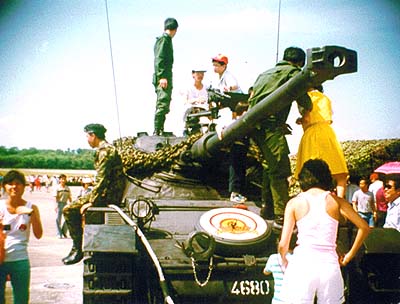
The 1980s - The consolidation years

(ABOVE) In an open house of the 1980s, the public is invited to explore this AMX-13 from the School of Armour. These open houses are used to keep the public informed of new equipment and technologies introduced.
In the 1980s, Singapore adopted the philosophy of TOTAL DEFENCE which is still in practice. This concept comprises five pillars of defence namely, Psychological Defence, Social Defence, Economic Defence, Civil Defence and Military Defence. This concept puts a part for every Singaporean to play in the defence of the home-land. In order to support the concept, citizens are kept informed of military equipment and new military procurements through SAF open houses. The armoured vehicles from the SAF Armour proved to be crowd-pullers amongst the various land system exibits during these open houses.
At this time, the SAF is no longer expanding rapidly like the early days, and is now at the consolidating phase. Faced with a defence expenditure pegged at 6% of the GDP, the spending have to be prioritised and hence the policy of upgrading existing assets was adopted. It was under this policy that the fleet of aging AMX-13s was subjected to a modernisation package by the Singapore Automotive Engineering (SAE) in the 1980s.
With Southeast Asia gearing towards a more peaceful climate, the SAF is however not complacent with her modernisation. In a Ministry of Defence Seminar in 1988, First Deputy Prime Minister Goh Chok Tong,who was then also the Defence Minister, stated that "Managing good relations with our neighbours is as important as the improvement we seek in our defence capability...We have developed an armed forces that is credible and we have endeavoured to maintain peace and stability in the region through good relations with our neighbours and our friendly nations." He added, however, that this diplomancy does not replace our defence capability and that the two must move in tandem. The key to maintaining stability is thus to discourage potential threats from appearing in the region. In order to achieve this, the SAF have to be up-to-date and operationally ready and therefore, the Armour Simulation Centre (ASC) was set up to enable active servicemen and reservists to hone their skills in peacetime.
|
1980 |
|
| unknown date | 46 SAR was transferred to the command of HQ 4 SAB, with its new home at Sungei Gedong. |
| 1 March | HQ RATC was shifted to Nee Soon Camp while its training Cadre remain in Kranji Camp. |
|
1982 |
|
| Unknown date | 46 SAR became the Divisional Reconnaissance Battalion (DRB). |
| 1 July | 42 SAR won the Best Combat Unit for work-year 1983/84 |
|
1983 |
|
| December | 42 SAR was temporarily decommissioned due to the restructuring of Armour. The decomissioning parade was held at the grounds of Selarang Barracks with the Chief Armour Officer, COL Colin Theseira, as the Guest-of-Honour. |
|
1984 |
|
| Unknown date | Armour was put in-charged of the organising of the 25th National Day Parade. |
| 1 July | 41 SAR won the Best Combat Unit for work-year 1983/84. |
| 26 September | 41 and 46 SAR participated in EX Matilda in Shoalwater Bay, Australia. It was thus the start for a long training stint for all Armour personels in the future. |
| 1 October | RATC shifted to Sungei Gedong Camp I. |
| 14 December | SOA was relocated to Sungei Gedong Camp II. |
|
1986 |
|
| 1 January | 46 SAR was activated for rescue operations of the trapped survivors under the rubbles of the collapsed Hotel New World. |
|
1988 |
|
| June | The first production AMX-13 SM1was handed over to the SAF by Singapore Automotive Engineering. |
| 15 August | AMX-13 SM1 was commissioned on 15 August at a parade held at the SOA. |
|
1989 |
|
| Unkown date | MINDEF has already been actively searching the market for a suitable vehicle to supplement, and possibly replacing, the ageing fleet of M113 APCs. Options such as the American Bradley, the Swedish CV-90, the German Marder & AV-90, and the British Warrior, which are currently avaliable in the market failed to meet the Army's specific requirements and hence, the idea for a locally-made vehicle was mooted. |
| 1 November | The Armour Simulation Centre (ASC) went into operation. |
| 17 November | The first Armour SKill at arms was held. |
[ History
& Organisation | Ex
Wallaby 1993 | Weapons
& Equipment | Photo
Archive ]
[ Links
| Bibliography
| Disclaimer | Acknowledgements
| Announcements
| Main
]